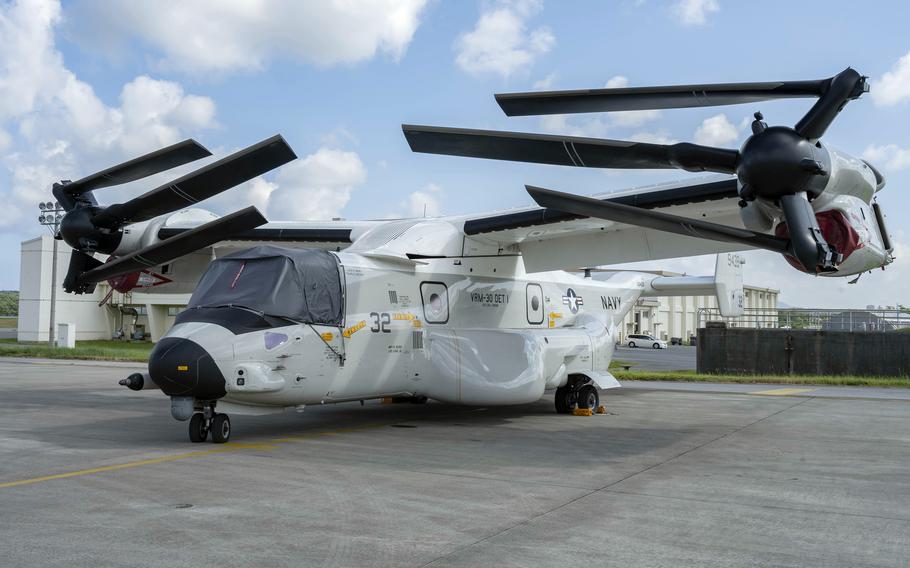
A CMV-22B Osprey sits on the tarmac at Kadena Air Base, Okinawa, Aug. 31, 2021. (David Krigbaum/U.S. Navy)
The mayor of a Japanese city, saying he was assured of the Osprey’s safety, has signed off on a U.S. Navy plan to put tiltrotors at the neighboring Marine Corps base.
Iwakuni Mayor Yoshihiko Fukuda at a city meeting Wednesday accepted the Navy’s plan to replace aging C-2A Greyhound transports with CMV-22 Ospreys at Marine Corps Air Station Iwakuni, a spokesperson for the city’s base affairs office told Stars and Stripes by phone Thursday.
Some Japanese government officials may speak to the press only on condition of anonymity.
The Navy in July said it will replace squadrons of Greyhounds and F/A-18 Super Hornet fighters at MCAS Iwakuni, just south of Hiroshima, with Ospreys and F-35C Lightning II stealth fighters.
By year’s end, four CMV-22s assigned to Fleet Logistics Multi-Mission Squadron 30, the service’s first Osprey squadron, will take over for Fleet Logistics Squadron 30, which flies the Greyhounds, according to the Navy.
The Ospreys will move personnel and cargo to and from the aircraft carrier USS George Washington, which is due to arrive at Yokosuka Naval Base, its new homeport south of Yokohama, later this year.
“We were able to confirm that this aircraft model update will not significantly affect the living environment of the residents living around the base,” Fukuda said at the meeting, according to video posted online by public broadcaster NHK.
Fukuda decided that the Osprey’s presence is necessary, considering the security environment surrounding Japan, the base affairs official said.
The city concluded that noise won’t increase since fewer aircraft will be flying from the air station under the modernization plan, the official said.
Japan’s government informed Iwakuni officials last month of the plan to deploy the Ospreys, he said.
The city government concluded the Ospreys are safe, based on their accident record and assurances from the U.S. and Japanese governments, according to a statement posted on the city’s website on Aug. 22.
The Nov. 29 crash of an Air Force Special Operations Command Osprey off the coast of southern Japan killed all eight crewmembers and prompted the Navy to ground the military’s 400 tiltrotors for three months. An accident investigation concluded the fatal crash resulted from a massive part failure coupled with pilot error.
The Marines were first to resume Osprey flights, followed by the Japan Ground Self-Defense Force, the U.S. Navy and the Air Force.
However, the tiltrotors are not permitted to fly their full range of missions until mid-2025, Vice Adm. Carl Chebi, the head of U.S. Naval Air Systems Command, told House lawmakers in July.
Japanese Defense Minister Minoru Kihara told reporters in Tokyo on Tuesday that he was grateful to the mayor for accepting the deployment.
Yamaguchi prefecture Gov. Tsugumasa Okamura also said he agreed with the plan on Thursday, according to Kyodo News report that day.
The Iwakuni mayor’s approval points to increased acceptance by the Japanese public of military deployments, said James Brown, an international affairs expert at Temple University’s Japan campus.
“Japan’s increased military budget and enhanced cooperation with the United States and other security partners will require many more military drills and deployments of weaponry,” he said by email Wednesday. “This process will, however, be significantly held up if the Japanese public are not onboard.”
The CMV-22B brings “agility, flexibility and sustainability to effectively operate our naval forces forward in a high-end fight,” Navy Lt. j.g. Sarah Merrill, a U.S. 7th Fleet spokeswoman, said by email Thursday.
The Osprey squadron’s presence at MCAS Iwakuni will support America’s commitment to the defense of Japan and the security and stability of the vital Indo-Pacific region, she added.